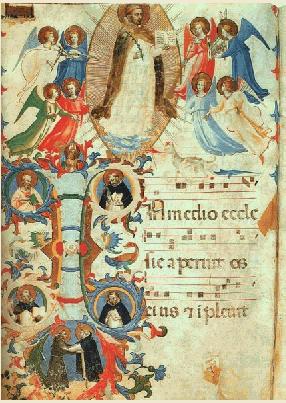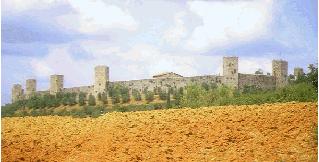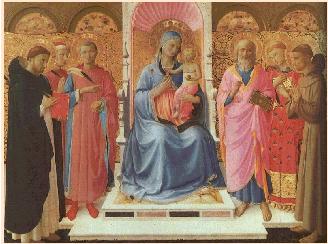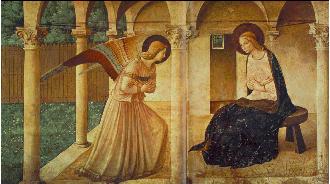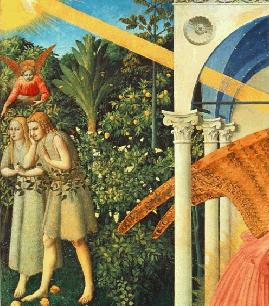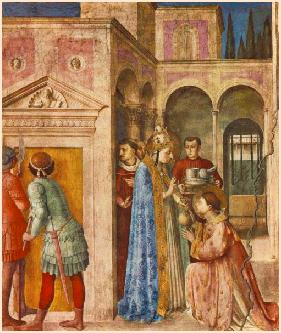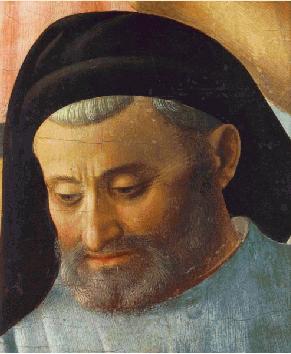
Candida Martinelli's Italophile Site

Main
Page This family-friendly site celebrates Italian culture for the enjoyment of children and
adults. Site-Overview
Knights of Art -
Fra Angelico
Visit
my Angels in Italian Art Page
Visit
my Canaletto and Venice Art Page
On-line images of art at Web
Gallery of Art: Nearly
a hundred years had passed by since Giotto lived and worked in Florence,
and in the same hilly country where he used to tend his sheep another
great painter was born. Many
other artists had come and gone, and had added their golden links of
beauty to the chain of Art which bound these years together. Some day
you will learn to know all their names and what they did. But now we
will only single out, here and there, a few of those names which are
perhaps greater than the rest. Just as on a clear night, when we look up
into the starlit sky, it would bewilder us to try and remember all the
stars, so we learn first to know those that are most easily recognised--the
Plough, or the Great Bear, as they shine with a clear steady light
against the background of a thousand lesser stars. The
name by which this second great painter is known is Fra Angelico, but
that was only the name he earned in later years. His baby name was
Guido, and his home was in a village close to where Giotto was born. He
was not a poor boy, and did not need to work in the fields or tend the
sheep on the hillside. Indeed, he might have soon become rich and
famous, for his wonderful talent for painting would have quickly brought
him honours and wealth if he had gone out into the world. But instead of
this, when he was a young man of twenty he made up his mind to enter the
convent at Fiesole, and to become a monk of the Order of Saint Dominic. Alterpiece in San Domenico in
Fiesole by Fra Angelico Every
brother, or frate, as he is called, who leaves the world and enters the
life of the convent is given a new name, and his old name is never used
again. So young Guido was called Fra Giovanni, or Brother John. But it
is not by that name that he is known best, but that of Fra Angelico, or
the angelic brother--a name which was given him afterwards because of
his pure and beautiful life, and the heavenly pictures which he painted. With
all his great gifts in his hands, with all the years of youth and
pleasure stretching out green and fair before him, he said good-bye to
earthly joys, and chose rather to serve his Master Christ in the way he
thought was right. The
monks of St. Dominic were the great preachers of those days--men who
tried to make the world better by telling people what they ought to do,
and teaching them how to live honest and good lives. But there are other
ways of teaching people besides preaching, and the young monk who spent
his time bending over the illuminated prayer- book, seeing with his
dreamy eyes visions of saints and white-robed angels, was preparing to
be a greater teacher than them all. The words of the preacher monks have
passed away, and the world pays little heed to them now, but the
teaching of Fra Angelico, the silent lessons of his wonderful pictures,
are as fresh and clear to-day as they were in those far-off years. Prayer
Book Illuminations by Fra Angelico Great
trouble was in store for the monks of the little convent at Fiesole,
which Fra Angelico and his brother Benedetto had entered. Fierce
struggles were going on in Italy between different religious parties,
and at one time the little band of preaching monks were obliged to leave
their peaceful home at Fiesole to seek shelter in other towns. But, as
it turned out, this was good fortune for the young painter-monk, for in
those hill towns of Umbria where the brothers sought refuge there were
pictures to be studied which delighted his eyes with their beauty, and
taught him many a lesson which he could never have learned on the quiet
slopes of Fiesole. The
hill towns of Italy are very much the same to-day as they were in those
days. Long winding roads lead upwards from the plain below to the city
gates, and there on the summit of the hill the little town is built. The
tall white houses cluster close together, and the overhanging eaves seem
almost to meet across the narrow paved streets, and always there is the
great square, with the church the centre of all. Walled Italian Hilltown It
would be almost a day's journey to follow the white road that leads down
from Perugia across the plain to the little hill town of Assisi, and
many a spring morning saw the painter-monk setting out on the convent
donkey before sunrise and returning when the sun had set. He would
thread his way up between the olive-trees until he reached the city
gates, and pass into the little town without hindrance. For the
followers of St. Francis in their brown robes would be glad to welcome a
stranger monk, though his black robe showed that he belonged to a
different order. Any one who came to see the glory of their city, the
church where their saint lay, which Giotto had covered with his
wonderful pictures, was never refused admittance. How
often then must Fra Angelico have knelt in the dim light of that lower
church of Assisi, learning his lesson on his knees, as was ever his
habit. Then home again he would wend his way, his eyes filled with
visions of those beautiful pictures, and his hand longing for the pencil
and brush, that he might add new beauty to his own work from what he had
learned. Several
years passed by, and at last the brothers were allowed to return to
their convent home of San Dominico at Fiesole, and there they lived
peaceably for a long time. We cannot tell exactly what pictures our
painter-monk painted during those peaceful years, but we know he must
have been looking out with wise, seeing eyes, drinking in all the beauty
that was spread around him. At
his feet lay Florence, with its towers and palaces, the Arno running
through it like a silver thread, and beyond, the purple of the Tuscan
hills. All around on the sheltered hillside were green vines and
fruit-trees, olives and cypresses, fields flaming in spring with scarlet
anemones or golden with great yellow tulips, and hedges of rose-bushes
covered with clusters of pink blossoms. No wonder, then, such beauty
sunk into his heart, and we see in his pictures the pure fresh colour of
the spring flowers, with no shadow of dark or evil things. The Virgin Mary and the Saints
by Fra Angelico Soon
the fame of the painter began to be whispered outside the convent walls,
and reached the ears of Cosimo da Medici, one of the powerful rulers of
Florence. He offered the monks a new home, and, when they were settled
in the convent of San Marco in Florence, he invited Fra Angelico to
fresco the walls. One
by one the heavenly pictures were painted upon the walls of the cells
and cloister of the new home. How the brothers must have crowded round
to see each new fresco as it was finished, and how anxious they would be
to see which picture was to be near their own particular bed. In all the
frescoes, whether he painted the gentle Virgin bending before the angel
messenger, or tried to show the glory of the ascended Lord, the artist-
monk would always introduce one or more of the convent's special saints,
which made the brothers feel that the pictures were their very own. Fra
Angelico had a kind word and smile for all the brothers. He was never
impatient, and no one ever saw him angry, for he was as humble and
gentle as the saints whose pictures he loved to paint. Annunciation, corridor of San
Marco by Fra Angelico It
is told of him, too, that he never took a brush or pencil in his hand
without a prayer that his work might be to the glory of God. Often when
he painted the sufferings of our Lord, the tears would be seen running
down his cheeks and almost blinding his eyes. There
is an old legend which tells of a certain monk who, when he was busily
illuminating a page of his missal, was called away to do some service
for the poor. He went unwillingly, the legend says, for he longed to put
the last touches to the holy picture he was painting; but when he
returned, lo! he found his work finished by angel hands. Often
when we look at some of Fra Angelico's pictures we are reminded of this
legend, and feel that he too might have been helped by those same angel
hands. Did they indeed touch his eyes that he might catch glimpses of a
Heaven where saints were swinging their golden censers, and white-robed
angels danced in the flowery meadows of Paradise? We cannot tell; but
this we know, that no other painter has ever shown us such a glory of
heavenly things. Adam and Eve by Fra Angelico Best
of all, the angel-painter loved to paint pictures of the life of our
Lord; and in the picture I have shown you, you will see the tender care
with which he has drawn the head of the Infant Jesus with His little
golden halo, the Madonna in her robe of purest blue, holding the Baby
close in her arms, St. Joseph the guardian walking at the side, and all
around the flowers and trees which he loved so well in the quiet home of
Fiesole. He
did not care for fame or power, this dreamy painter of angels, and when
the Pope invited him to Rome to paint the walls of a chapel there, he
thought no more of the glory and honour than if he was but called upon
to paint another cell at San Marco. Painting in Pope's private
chapel by Fra Angelico But
when the Pope had seen what this quiet monk could do, he called the
artist to him. `A
man who can paint such pictures,' he said, `must be a good man, and one
who will do well whatever he undertakes. Will you, then, do other work
for me, and become my Archbishop at Florence?' But the painter was
startled and dismayed. `I
cannot teach or preach or govern men,' he said, `I can but use my gift
of painting for the glory of God. Let me rather be as I am, for it is
safer to obey than to rule.' But
though he would not take this honour himself, he told the Pope of a
friend of his, a humble brother, Fra Antonino, at the convent of San
Marco, who was well fitted to do the work. So the Pope took the
painter's advice, and the choice was so wise and good, that to this day
the Florentine people talk lovingly of their good bishop Antonino. Detail from Deposition by Fra
Angelico See my Angels in Italian Art page for more
Fra Angelico images
Return to: Stories of the Italian Painters by Amy Steedman

